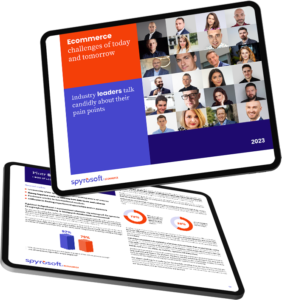How to increase ecommerce conversion rate in your businesses
A fast way of life and users’ appreciation of their comfort contributes to the constant development of the ecommerce market and online shopping. Companies from this sector more and more often have to fight for the attention of customers and develop methods, thanks to which their transactions will be brought to the end of the purchasing path. To help optimise the website and understand customer behaviour, it’s worth taking a look at the ecommerce conversion rate.
In this article, we present selected strategies that will help you increase ecommerce conversion rates of the website and make your business prosper even better.
What is the ecommerce conversion rate?
For years, ecommerce conversion rate has been one of the most important metrics used to measure the actual success of an online store, ecommerce website or business venture. So, what is a conversion rate, really?
In general, the conversion rate (CR) is one of the key performance indicators that shows the percentage of visitors to a website or landing page who perform a specific action intended as a goal of the website. These objectives can be very diverse, but for ecommerce businesses, they mainly revolve around the user making a purchase. The main aim of the website is known as the macro conversion.
Of course, every website or online shop can also have smaller goals, such as having users sign up for newsletters or placing a product on a user wish list. These actions are usually applied before the main purpose is fulfilled by the user and are called micro conversions.
How to calculate ecommerce conversion rate?
The ratio of the average ecommerce conversion rate is calculated by dividing the number of conversions (e.g., online store transactions) for a given period of time by the total number of visits to the ecommerce site in the same time frame. Then the result is multiplied by 100 to get the percentage value.
The formula for average ecommerce conversion rates
Tracking the ecommerce conversion rate is essential for improving it, and also can contribute to better management of the entire ecommerce site.
Additionally, it is essential to mention that what we consider to be a good conversion rate in ecommerce should be strongly dependent on the specifics of the business, namely what we sell and to whom. This is especially worth bearing in mind when defining the rate, we will be aiming for, so that our goal is actually achievable.
Conversion rate optimisation
The improvements in the online store conversion rate hardly can come without the proper optimisation. Conversion rate optimisation (CRO) is a systematic process of improving ecommerce conversion rate by increasing the proportion of website users who complete the customer journey by taking the desired action. This process focuses on understanding how users navigate the site, what actions they take, and what is getting in their way of fulfilling your business goals. A thorough understanding of these factors will help you navigate what steps a company or ecommerce store should take to achieve better website performance and a greater average conversion rate.
To properly conduct the optimisation process, it is useful to carry out a regular review of the ecommerce conversion rates of a website in different time frames and thus make it easier to continuously track the implemented adjustments and optimisation strategies, and their impact.
Discover what challenges ecommerce leaders face in their everyday work
Download free ebookMethods to boost conversion rates
There are many factors that influence ecommerce conversion rates. Some of them revolve around content-related matters, others around UX design and page speed or security issues. With that in mind, you should also expect the existence of a whole range of various improvements that can be made in your business to achieve a good ecommerce conversion rate.
Below we have listed some strategies and tips which, if implemented successively, can help to boost ecommerce conversion rates and online sales on your site.
Optimise ecommerce website loading speed
The first thing you should tackle when optimising your ecommerce site is to decrease loading time of your ecommerce websites. You have only a few seconds to get the attention of a potential customer. A long waiting period before the page is displayed can effectively discourage the user from using it, and thus reduces the possibility of conversion. To speed up your ecommerce website, you can take the following actions:
- Choose fast hosting.
- Keep graphics in the right size and format (use JPGs and compress photos).
- Use external hosting for videos posted on the site.
- Reduce the number of unnecessary plug-ins on the ecommerce website.
- Use a website caching system.
- Keep your website code clear and get rid of all the unnecessary bits.
Focus on content for better ecommerce conversions
When improving the conversion rate, it is worth remembering about the appropriate content and product images. A well-prepared copy, product descriptions and product photo can both convince the site visitors to a given product and help keep them on the site longer. Of course, in this matter, it is also important to remember about SEO and the use of adequate keywords which can have a good effect on both organic traffic and the optimisation of content for users and potential customers.
As you plan the content for your ecommerce website, you need to make sure that your message is plain and as informative as possible. Your products must be well described so that all relevant details are easily accessible and fully understood by the user. To achieve this, you can use snippets, descriptions and bulleted details that stand out and are clearly visible for site visitors.
The content optimisation process is also a good time to look at your call to action. Abandoning a page in the early stages can be related to issues with that very button. In this case, when creating copy that needs to excite the user, it is helpful to play with words while maintaining the persuasive nature of the communication. When creating a CTA, you should also remember to make sure it is properly placed and visible, so if you see the need to make the button bigger, don’t hesitate.
Furthermore, to boost the content on the page, images and other visuals can also be used. However, you should remember that they must be selected accordingly and be of good quality.
UX improvements for better conversion rate
Another important part of the ecommerce conversion rate optimisation strategy is the UX and responsive design of the ecommerce website. What is crucial with these improvements is that they should apply to both desktop and mobile versions of the online store.
A well-designed platform should be easy to navigate and adjust automatically to the type of device and size of the browser window. A nicely created website with clear navigation can help to maintain user engagement and maximise search engine functionality to better understand customer preferences. That is why it is essential to always keep users in mind when designing both the page and its navigation.
To improve your navigation, you need to take care of issues such as:
- Appropriate site architecture – e.g., through clear menus with categories and subcategories, the ability to use filters, or on-page searching.
- Plain design layout – keep the site clean and readable so that the visitor can use it without a second thought.
- Breadcrumbs – for the user to keep track of their current location on the site and make it easy to return to previously visited sub-pages.
- Footer – that contains links to sub-pages such as terms and conditions, delivery, returns, careers, or contact.
An overall upgrade of the user experience on ecommerce sites also supports the customer journey, as both aspects have a major influence on each other and can encourage customers to go through the entire shopping and checkout process.
Examine the customer journey and checkout form
Equally important as UX is the simplification of the customer journey and checkout process. The customer path is the direct link that keeps the user engaged and present on the website. For this reason, it is extremely important to ensure that it is both comprehensible and attractive. When optimising the customer journey, it is worth paying particular attention to the checkout process since this is where cart abandonment is most likely to occur. Good practices, in this case, are to simplify the process by reducing the number of steps and allowing for guest checkout.
Reducing the number of stages in the purchasing and checkout process will help to speed up the customer’s buying experience and shorten the conversion funnel. And the ability to buy as a guest will make the process easier for users who are shopping on the go or even using the mobile version of the website. In addition, with this option, you won’t be scaring off potential online shoppers who don’t yet feel ready to create an account.
Good offer and communication
To convince the user to both stay on the site and convert their purchase, you need a broad and competitive offer. In this regard, you can focus on product quality, as well as launching discounts or sales. However, what is important to remember is the fact that the offer is not only about the products, but also about aspects such as the possibility to choose from a variety of cheap or free delivery services and multiple payment methods. Nowadays, many different options and solutions can be found for both these aspects. So many that it is usually impossible for a shop to have them all. Therefore, when preparing market research, it is worth checking which solutions and providers are the most popular and widely used, and then selecting and offering the services of a few of them.
It is also fundamental for offerings to be presented and communicated in a right and easy-to-understand way. Consequently, all additional aspects of the offer should be highlighted fittingly on the website and matters such as promotions and discounts should be well explained on the page and include information about the end of its validity. Taking proper care of offers and their communication on the sales pages of the online store can not only increase ecommerce conversion rates, but also has a chance to contribute to a higher average order value.
Highlight security to grow ecommerce conversion rates
Well-prepared communication is also significant when it comes to site security. In a world of cybersecurity breaches, it is crucial, especially for ecommerce businesses with access to sensitive information, to keep your user’s data as safe as possible. Potential customers need to feel secure before leaving their personal or credit card details on the website. That is why it is a good idea to show users that the website is secured in several ways, for example by applying HTTPS protocol, an SSL certificate or using a reputable website security service provider.
Showcase social proof and improve conversions
Another key point when optimising conversions is to include a review section on the website. This helps to generate more interest and trust from the potential buyer. For many users, social proof in the form of reviews helps to boost their confidence in both the product and the overall purchasing process, and thus gives them a sense of making a fully informed shopping decision. Displaying a review section on a page is often fairly simple. This can usually be done quickly by adding a pre-made plugin, widget, or extension to the website.
An alternative to reviews is the introduction of a rating system. This is an option that can be used in cases where buyers do not find the time to provide a review, and it only takes a brief moment to complete the rating scale. Both of these options are very appealing to potential buyers and can have a positive effect on your average ecommerce conversion rates.
Relevance of research and analysis for ecommerce conversion rates
One of the major points in gaining more conversions is conducting research and analysis on user behaviour and customer feedback. Thereby, you will no longer have to guess your users’ needs, instead, you will be able to understand your target audience and existing customers better and back up all your decisions with the results of your studies. Knowing your clients’ intentions as well as adapting your website and shopping path to them is one of the best ways to satisfy potential buyers and increase your ecommerce conversion.
Additionally, all the strategies above should be complemented by such tests and analyses, so that you can always be sure whether a particular strategy works in your case. For this purpose, it is advisable to use A/B tests, which allow you to set up two variants of the website and test them on users divided into two groups. Based on this knowledge, you can easily determine which version of the site users like best, and thus which converts better.
Why does the ecommerce conversion rate matter?
There are many reasons for an ecommerce business to focus on average conversion rate. Together with other indicators, it plays a significant role in the overall performance of online stores and ecommerce sales figures. The two main benefits that come with conversion rate optimisation are increased income for your business and a better perception of your brand and product value.
Boosting the ecommerce conversion rate is the most cost-effective way of building income by getting more sales without having to spend extra budget on marketing and advertising activities. And as for the value, paying extra attention to the quality of the UX and content, reassuring users about the standard of products and taking care of the whole purchasing experience make the entire business perceived as more valuable and worth returning and recommending.
Enhance ecommerce CRO and boost conversions with Spyrosoft
To summarise, applying the practices and strategies outlined above can help increase your ecommerce conversion rate, which ultimately results in gaining and retaining more website visitors and achieving much better ecommerce sales results. So, if you need any help in getting better outcomes in your ecommerce business, check our offer and reach out to our experienced team.
About the author
Contact us





